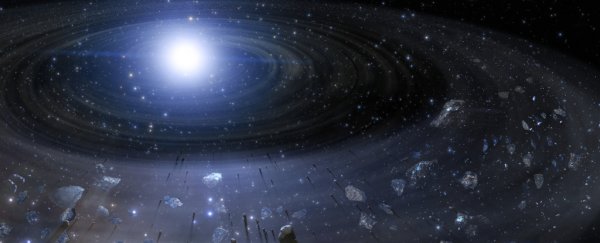There's a lot we don't know about planets outside the Solar System.
They are small, dim, and distant, which means that we don't have a lot of detailed information about what they're made of. This is especially true for rocky exoplanets, like Earth, Venus, and Mars, of which we can't currently see the surfaces.
There is, however, one way we can peer into the guts of rocky worlds – and it suggests that some of the minerals they're made of are nothing like the minerals in the Solar System. So alien are these minerals, in fact, that scientists had to invent new terms to classify them.
The method for doing this is analyzing the atmospheres of white dwarf stars, which can become 'polluted' with minerals from planets and asteroids that have fallen into the stars. The study of these destroyed exoplanets is called necroplanetology.
"Polluted white dwarfs reveal greater planetary variety in our solar neighborhood than currently appreciated, with consequently unique planetary accretion and differentiation paths that have no direct counterparts in our Solar System," the researchers write in their paper.
"These require new rock classification schemes."
White dwarfs are what happens to a star like the Sun when it reaches the end of its main-sequence lifespan, causing its core to collapse into an ultra-dense object shining brightly with residual heat. Meanwhile, its outer skin expands across its solar system as a vast bubble of hot gases.
Astonishingly, exoplanets can survive this process – but their orbits can change, becoming unstable, resulting in tidal disruption (that's when the gravitational field of the star pulls the exoplanet apart) and accretion (when the debris from the shredded exoplanet falls onto the star).
When this occurs, the elements in the exoplanets are incorporated into the star, changing the light the star emits. Planetary scientists can then analyze this light, looking for elements that wouldn't normally be found in a white dwarf's atmosphere, to work out what the rocky bodies were made of. This is the science of necroplanetology.
Geologist Keith Putirka of California State University and astronomer Siyi Xu of the National Science Foundation's NOIRLab ran such analyses on 23 white dwarfs, all within 650 light-years of the Sun. For each of these stars, previous observations showed the presence of elements such as calcium, silicon, magnesium, and iron.
Because white dwarfs are so dense, heavier elements like these shouldn't be present in the atmosphere, but drawn into the star's interior, where they would not be detectable. Their presence suggests relatively recent accretion of rocky material.
Purtika and Xu analyzed the abundances of these elements in the white dwarf atmospheres to try and reconstruct the mineral composition of the rocky parent bodies. What they found was surprising.
"While some exoplanets that once orbited polluted white dwarfs appear similar to Earth, most have rock types that are exotic to our Solar System," says Xu. "They have no direct counterparts in the Solar System."
The researchers devised a number of new terms to classify these rocks and their exotic compositions, including quartz pyroxenites, quartz orthopyroxenites, periclase dunites, periclase wehrlites, and periclase clinopyroxenites.
These rocks might be able to tell us a lot about the sorts of exoplanets they came from, and their evolution, the researchers say. And this information could have implications for assessing exoplanet habitability, too.
"Some of the rock types that we see from the white dwarf data would dissolve more water than rocks on Earth and might impact how oceans are developed," Purtika says.
"Some rock types might melt at much lower temperatures and produce thicker crust than Earth rocks, and some rock types might be weaker, which might facilitate the development of plate tectonics."
In addition, learning more about rocky exoplanet compositions via necroplanetology could help us answer some existential questions about our own place in the Universe. For example, we might find that some regions of the galaxy are more likely to form Earth-like planets than other regions.
"Exoplanet studies also force us to face still unresolved questions of why Earth is so utterly different from its immediate planetary neighbors, and whether such contrasts are typical or inevitable," the researchers explain.
The research has been published in Nature Communications.
